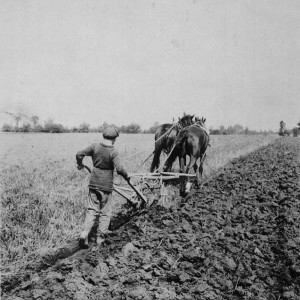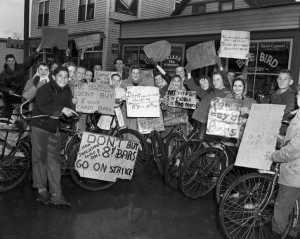10.9 Historicizing Childhood: The Changing Fortunes of Children and Youth in Canada
Georgia Sitara, Department of History, University of Victoria

The experiences of children and youth underwent profound change from the 19th century to the end of the 20th century.
In the 19th century, children and youth were important contributors to the family economy. Most children learned by working alongside adults. Children’s work, both paid and unpaid, was crucial to their own and to their families’ well-being and survival. Only in the postwar (post World War II) era did mothers replace children as their families’ secondary earners.
At the beginning of the 21st century, everyday life for most children in Canada revolved around school. This way of life, which made schooling the central organizing principle of children’s lives, has its roots in the first Canadian compulsory education legislation enacted in 1870 and mandated children to attend school for four months of the year. Even then, work, family responsibilities, and other considerations meant that attendance for most children remained irregular, despite families’ hopes for their children’s education and future.
The idea of childhood as a time in which children did not work took over a century to put into everyday practice. The first Canadian legislation to regulate child labour, the Ontario Factory Acts of 1884, legislated boys, 12 years and over, and girls, 14 years and older, to work no more than 10 hours a day, six days a week. Despite the protective legislation, families’ needs and individuals’ survival meant that in practice boys and girls continued to work. Well into the 20th century, reform efforts and even child protection organizations expected children and youth to work. Work was considered a necessary part of their training in the habits of thrift and industry as well as responsible citizenship.
Historian Dorothy Chunn suggests that we should interpret education, labour, and other legislation as the codification of childhood and youth as a time of dependence.[2] In Dominion of Youth, Cynthia Comacchio demonstrates that by the 1920s, children and youth were growing up very differently from their parents.[3]
Alongside these historic shifts, children and youth continue to appear in the most unlikely places in the 20th century. Between 1880-1930, over 80,000 Home Children immigrated to Canada without their families.[4] At least 20,000 underage soldiers enlisted and served in World War I.[5] One of the eight On to Ottawa Trek leaders to meet with Prime Minister Robert Bennett in 1935 was 14 years old. Children and youth across Canada held a chocolate bar strike in 1947 when, to their horror and disgust, the price of chocolate bars went from five to eight cents. From the spectacular to the ordinary, children and youth made history.

Work continued to be a factor in most children’s lives. In the 1940s, some youth were self-supporting by the age of 14. Neil Sutherland’s work on the history of children and youth in British Columbia shows that as late as the 1960s, youth recall, “we always had things to do.”[6] Indigenous children and youth in residential school always worked more than they studied.
It is a painful irony, and it should not be ignored, that the century that invented childhood as a time of innocence and dependence also endangered children and youth in unprecedented ways. Institutions that were established in the name of protection, as Steven Maynard demonstrates, often locked danger in.[7] Revelations about the brutal and genocidal conditions in Residential schools were made as early as 1907 by the Indian Affairs medical officer P.H. Bryce, and disturbing disclosures continue to unfold in our own day.[8] Richard Cardinal’s 1984 Diary of a Métis Child is a testament in a youth’s own words: policies and practices established for the protection of children created suffering and have resulted in deadly harm.[9]
The lives of children and youth were transformed over the course of the 20th century and not always in a good way.
Questions for Discussion
What is the age of the historical subject in your head? Is adult the default historical subject?
What do children and youth gain over the course of the 20th century? What do children and youth lose?
In what ways did children and youth gain and lose power over the course of the 20th century?
Key Points
- Childhood in the post-Confederation era changed over time, and its experience varied based on geographic and racialized context.
- Children’s labour was a recognizable feature of life in Canadian households until after WWII.
- Regulation of child labour was slow in coming, largely because the expectation was widespread that children’s work was valuable in and of itself.
- As early as the 1920s, the transformation of childhood into a period of dependence was visible.
- The creation of more institutions and systems to regulate childhood too often created significant hazards to the welfare of children.
Additional Readings
Adams, Mary Louise. The Trouble with Normal: Postwar Youth and the Making of Heterosexuality. Toronto: University of Toronto Press, 1997.
Dauda, Carol L. “Childhood, Age of Consent and Moral Regulation in Canada and the UK.” Contemporary Politics 16.3 (August 2010): 227-247.
Milloy, John S. A National Crime: The Canadian Government and the Residential School System, 1879 to 1986. Winnipeg: University of Manitoba Press, 1999.
Parr, Joy and Nancy Janovicek. Eds. Histories of Canadian Children and Youth. Don Mills: Oxford University Press, 2003.
Parr, Joy. Ed. Childhood and Family in Canadian History. Toronto: McClelland and Stewart, 1982.
Prentice, Alison. The School Promoters: Education and Social Class in Mid-Nineteenth Century Upper Canada. Toronto: McClelland Stewart, 1977.
Rollings-Magnusson. Heavy Burdens on Small Shoulders: The Labour of Canadian Children on the Canadian Prairies. Edmonton: University of Alberta Press, 2009.
Sutherland, Neil. Children in English-Canadian Society: Framing the Twentieth-Century Consensus. Waterloo: Wilfrid Laurier University Press, 2000.
Truth and Reconciliation Commission. “They Came for the Children: Canada, Aboriginal Peoples and Residential Schools.” 2012. http://www.myrobust.com/websites/trcinstitution/File/2039_T&R_eng_web%5B1%5D.pdf
Attributions
Figure 8.18
Boy ploughing at Doctor Barnardo’s Industrial Farm (Online MIKAN no.3521627) by Library and Archives Canada / PA-117285 is in the public domain.
Figure 8.19
EA-600-42a by Lenny Flank is in the public domain.
- Growing Up Canadian, directed by Sheila Petzold and Susan Terrill, produced by Hoda Elatawi (Montreal: National Film Board, 2003) http://onf-nfb.gc.ca/en/our-collection/series/?ids=516825&nom=Growing%20Up%20Canadian ↵
- Dorothy Chunn. “Boys Will Be Men, Girls Will be Mothers: The Legal Regulation of Childhood in Toronto and Vancouver.” In Histories of Canadian Children and Youth, ed. by Joy Parr and Nancy Janovicek (Don Mills: Oxford University Press, 2003): 188-206. ↵
- Cynthia Comacchio, Dominion of Youth: Adolescence and the Making of Modern Canada, 1920-1950 (Waterloo: Wilfrid Laurier Press, 2008). ↵
- Joy Parr. Labouring Children: British Immigrant Apprentices to Canada, 1869-1924 (Toronto: University of Toronto Press, 1994). ↵
- Tim Cook, “‘He was Determined to Go’: Underage Soldiers in the Canadian Expeditionary Force,” Histoire Sociale, Social History 41.81 (2008): 41-74. ↵
- Neil Sutherland, “‘We always had things to do’: The Paid and Unpaid Work of Anglophone Children Between the 1920s and the 1960s.” Labour / Le Travail 25 (Spring 1990): 105-141. ↵
- Steven Maynard, “‘Horrible Temptations’: Sex, Men and Working-Class Male Youth in Urban Ontario, 1890-1935,” Canadian Historical Review 78. 2 (June 1997): 191-235. ↵
- Cindy Blackstock, Wanted: Moral Courage in Canadian Child Welfare,” First Peoples Child & Family Review, 6.2 (2011): 35-46. ↵
- Richard Cardinal: Cry From the Diary of a Métis Child, Directed by Alanis Obamsowin (Montreal: National Film Board, 1986). ↵

